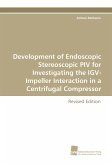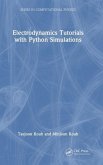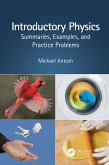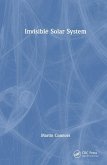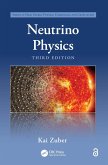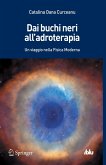Christopher K. Walker
Investigating Life in the Universe
Astrobiology and the Search for Extraterrestrial Life
Christopher K. Walker
Investigating Life in the Universe
Astrobiology and the Search for Extraterrestrial Life
- Gebundenes Buch
- Merkliste
- Auf die Merkliste
- Bewerten Bewerten
- Teilen
- Produkt teilen
- Produkterinnerung
- Produkterinnerung
This textbook gives a lively introduction to the search for extraterrestrial life. It is a guidebook to understanding the possibility of life elsewhere, pointing out landmarks and providing background information to facilitate further exploration of those areas most interesting to each reader.
Andere Kunden interessierten sich auch für
![Development of Endoscopic Stereoscopic PIV for Investigating the IGV-Impeller Interaction in a Centrifugal Compressor Development of Endoscopic Stereoscopic PIV for Investigating the IGV-Impeller Interaction in a Centrifugal Compressor]() Arman MohseniDevelopment of Endoscopic Stereoscopic PIV for Investigating the IGV-Impeller Interaction in a Centrifugal Compressor45,99 €
Arman MohseniDevelopment of Endoscopic Stereoscopic PIV for Investigating the IGV-Impeller Interaction in a Centrifugal Compressor45,99 €![Electrodynamics Tutorials with Python Simulations Electrodynamics Tutorials with Python Simulations]() Taejoon KouhElectrodynamics Tutorials with Python Simulations174,99 €
Taejoon KouhElectrodynamics Tutorials with Python Simulations174,99 €![Introductory Physics Introductory Physics]() Michael AntoshIntroductory Physics163,99 €
Michael AntoshIntroductory Physics163,99 €![Invisible Solar System Invisible Solar System]() Martin ConnorsInvisible Solar System174,99 €
Martin ConnorsInvisible Solar System174,99 €![Neutrino Physics Neutrino Physics]() Kai ZuberNeutrino Physics152,99 €
Kai ZuberNeutrino Physics152,99 €![Raman Scattering on Emerging Semiconductors and Oxides Raman Scattering on Emerging Semiconductors and Oxides]() Zhe FengRaman Scattering on Emerging Semiconductors and Oxides131,99 €
Zhe FengRaman Scattering on Emerging Semiconductors and Oxides131,99 €![Dai buchi neri all'adroterapia Dai buchi neri all'adroterapia]() Catalina Oana CurceanuDai buchi neri all'adroterapia21,99 €
Catalina Oana CurceanuDai buchi neri all'adroterapia21,99 €-
-
-
This textbook gives a lively introduction to the search for extraterrestrial life. It is a guidebook to understanding the possibility of life elsewhere, pointing out landmarks and providing background information to facilitate further exploration of those areas most interesting to each reader.
Hinweis: Dieser Artikel kann nur an eine deutsche Lieferadresse ausgeliefert werden.
Hinweis: Dieser Artikel kann nur an eine deutsche Lieferadresse ausgeliefert werden.
Produktdetails
- Produktdetails
- Verlag: Taylor & Francis Ltd
- Seitenzahl: 228
- Erscheinungstermin: 16. November 2023
- Englisch
- Abmessung: 254mm x 178mm
- Gewicht: 300g
- ISBN-13: 9781138628717
- ISBN-10: 1138628719
- Artikelnr.: 59983715
- Verlag: Taylor & Francis Ltd
- Seitenzahl: 228
- Erscheinungstermin: 16. November 2023
- Englisch
- Abmessung: 254mm x 178mm
- Gewicht: 300g
- ISBN-13: 9781138628717
- ISBN-10: 1138628719
- Artikelnr.: 59983715
Professor Christopher K. Walker has over 30 years of experience designing, building, and using state-of-the-art receiver systems for terahertz astronomy. He is a Professor of Astronomy, Optical Sciences, Aerospace and Mechanical Engineering, and Applied Mathematics, and an Associate Professor of Electrical and Computer Engineering at the University of Arizona (UofA), USA. He has published numerous papers on star formation and terahertz (THz) technology. He has served as dissertation director for a number of PhD students and been a topical editor for IEEE Transactions on Terahertz Science and Technology. While working on his master's in Electrical and Computer Engineering at the Ohio State University, he was chief engineer of the "Big Ear" radio telescope, which conducted one of the first all-sky searches for extraterrestrial intelligence (SETI). Upon completing his MS, he worked at TRW Aerospace on microwave satellite systems and then at the Jet Propulsion Laboratory (JPL) on SETI and interplanetary radar. He then earned a PhD in Astronomy from the UofA. As a Millikan Fellow in Physics at Caltech, he worked on the development of low-noise, SIS waveguide receivers above 400 GHz and explored techniques for etching waveguide out of silicon. On joining the UofA faculty in 1991, he began the Steward Observatory Radio Astronomy Lab (SORAL), which has become a world leader in developing THz receiver systems for astronomy and other remote sensing applications. Instruments developed by Walker's team have served as primary facility instruments at the Heinrich Hertz Telescope on Mt. Graham, AZ, and the AST/RO telescope at the South Pole and have been used at the APEX telescope on the Chajnantor plateau in Chile's Atacama region. Walker led the effort to design and build the world's largest (64 pixels) submillimeter-wave heterodyne array receiver. He was Principal Investigator (PI) of the NASA long-duration balloon project, the Stratospheric THz Observatory (STO), which flew in Antarctica in 2012 and 2016. He is now PI of GUSTO, a balloon-borne mission under the auspices of the NASA Explorer Program and CatSat, a 6U CubeSat that demonstrates a new deployable antenna technology. Walker is co-founder of FreeFall Aerospace, which commercializes this technology. He was selected by the NASA Innovative Advanced Concepts (NIAC) program for both a Phase I and Phase II study. He authored Terahertz Astronomy, the first textbook in his field of study. He was named a Galileo Circle Fellow in 2015 by the College of Science of the University of Arizona. He has a loving wife and two children who have supported him through many observing runs, Antarctic deployments, and late nights.
Preface.
Chapter 1. Drake Equation: An Overview
Chapter 2. Setting the Stage for Cosmic Discovery
Chapter 3. The Birth of Observational Astrophysics
Chapter 4. Stellar Evolution
Chapter 5. Planet Evolution
Chapter 6. The Origin of Life
Chapter 7. Evolution of Life and Intelligence
Chapter 8. Habitable Worlds
Appendix 1
Appendix 2
Appendix 3
Appendix 4
Appendix 5
Appendix 5
Chapter 1. Drake Equation: An Overview
Chapter 2. Setting the Stage for Cosmic Discovery
Chapter 3. The Birth of Observational Astrophysics
Chapter 4. Stellar Evolution
Chapter 5. Planet Evolution
Chapter 6. The Origin of Life
Chapter 7. Evolution of Life and Intelligence
Chapter 8. Habitable Worlds
Appendix 1
Appendix 2
Appendix 3
Appendix 4
Appendix 5
Appendix 5
Preface.
Chapter 1. Drake Equation: An Overview
Chapter 2. Setting the Stage for Cosmic Discovery
Chapter 3. The Birth of Observational Astrophysics
Chapter 4. Stellar Evolution
Chapter 5. Planet Evolution
Chapter 6. The Origin of Life
Chapter 7. Evolution of Life and Intelligence
Chapter 8. Habitable Worlds
Appendix 1
Appendix 2
Appendix 3
Appendix 4
Appendix 5
Appendix 5
Chapter 1. Drake Equation: An Overview
Chapter 2. Setting the Stage for Cosmic Discovery
Chapter 3. The Birth of Observational Astrophysics
Chapter 4. Stellar Evolution
Chapter 5. Planet Evolution
Chapter 6. The Origin of Life
Chapter 7. Evolution of Life and Intelligence
Chapter 8. Habitable Worlds
Appendix 1
Appendix 2
Appendix 3
Appendix 4
Appendix 5
Appendix 5

